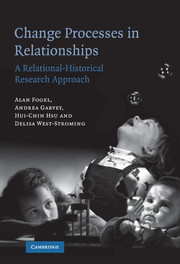Book contents
- Frontmatter
- Contents
- List of figures
- List of tables
- Acknowledgments
- Prologue Overview of the research problem and summary of findings
- 1 Relationships as developing systems: theoretical foundations
- 2 Mother-infant relationship development in the first six months: from face-to-face play to object play
- 3 Relational-historical research on developmental change
- 4 Relational-historical research: the multiple case study approach, frame analysis, qualitative and quantitative analysis
- 5 Research propositions about relationship change processes
- 6 Research methods for the current investigation: subjects, procedures, and data analysis
- 7 Results of the current investigation: quantitative analysis of developmental changes in relationship frames and in infant actions
- 8 Results of the current investigation: qualitative analysis of Richard and his mother
- 9 Results of the current investigation: qualitative analysis of Betsy and her mother
- 10 Results of the current investigation: qualitative analysis of Lewis and his mother
- 11 Results of the current investigation: qualitative analysis of Susan and her mother
- 12 Summary of findings on relational-historical change
- Epilogue Laws of change: implications for theory and practice
- References
- Author index
- Subject index
10 - Results of the current investigation: qualitative analysis of Lewis and his mother
Published online by Cambridge University Press: 22 September 2009
- Frontmatter
- Contents
- List of figures
- List of tables
- Acknowledgments
- Prologue Overview of the research problem and summary of findings
- 1 Relationships as developing systems: theoretical foundations
- 2 Mother-infant relationship development in the first six months: from face-to-face play to object play
- 3 Relational-historical research on developmental change
- 4 Relational-historical research: the multiple case study approach, frame analysis, qualitative and quantitative analysis
- 5 Research propositions about relationship change processes
- 6 Research methods for the current investigation: subjects, procedures, and data analysis
- 7 Results of the current investigation: quantitative analysis of developmental changes in relationship frames and in infant actions
- 8 Results of the current investigation: qualitative analysis of Richard and his mother
- 9 Results of the current investigation: qualitative analysis of Betsy and her mother
- 10 Results of the current investigation: qualitative analysis of Lewis and his mother
- 11 Results of the current investigation: qualitative analysis of Susan and her mother
- 12 Summary of findings on relational-historical change
- Epilogue Laws of change: implications for theory and practice
- References
- Author index
- Subject index
Summary
In this chapter, we present a case analysis of the development of frames and frame transitions for another one of the four representative dyads, Lewis and his mother. Similar to the organization utilized in previous qualitative chapters, we present the raw data developmental trajectories for each of the four frames, the raw data transition frequencies between the frames as a function of age, and a qualitative analysis of the relational history. In the latter, we describe the change processes at two levels, ordinary variability (referred to as level 1 change in Chapter 3) and innovations (referred to as level 2 change in Chapter 3), followed by a brief developmental account of these changes that describes any evidence for a developmental re-organization (level 3 change).
Developmental trajectories and transition frequencies
As shown in Figure 7.2 and Table 10.1, for this dyad the guided object frame persisted as the historically predominant frame until session 8, after which social, social/object mixed, and not-guided object frames became more salient. Social and social/object mixed frames were salient features of their communication throughout the period of observation. Unlike the other two dyads reviewed thus far, not-guided object frames for Lewis and his mother never became predominant on its own. Rather, the not-guided object and the social/object mixed frames seemed to share equal status as the newly emerging frames. The significant negative correlation (Table 7.2) between the not-guided object frame and the social/object mixed frame lends further support to this conclusion.
- Type
- Chapter
- Information
- Change Processes in RelationshipsA Relational-Historical Research Approach, pp. 172 - 187Publisher: Cambridge University PressPrint publication year: 2006

